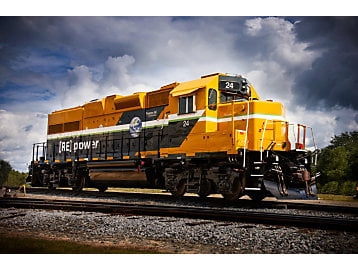Railroading is continually being improved upon. You can see it in the physical plant (infrastructure – rails, ties, roadbed, structures, signals, overhead catenary where in use), the rolling stock and equipment (motive power, rail cars – freight, passenger, maintenance of right-of-way) and in operations.
To be clear, the basic operating premise has, over the years, seen extremely limited change: The platform today is nearly identical to what railroading’s forebears bore witness to when rails were first laid right down to the sleepers (ties) – granite (stone) or wood (we’re talking circa 1827 in America). Development, on the other hand, has been anything but sedentary; pace progress anything but snail-like.
One area of such development is in regard to diesel-electric locomotive-emissions-reduction work.
Locomotive (a “Trains Magazine Special Edition” – “No. 1-2007”) Editor Greg McDonnell perhaps summed it best. McDonnell writes: “At the dawn of the diesel age, the need to reduce or eliminate smoke from locomotives – particularly in urban areas – helped kick-start the revolution that would dieselize North American railroads within a few short decades. It’s no coincidence that Central Railroad of New Jersey 1000, the first commercially successful diesel-electric locomotive in America, went to work in the Bronx in 1925, the same year that New York City passed smoke abatement laws banning the operation of steam locomotives within the city limits.”1 McDonnell goes on in the same article to state that the standards applied regarding the then current diesel-electric locomotive-operating-performance realm were every bit as much in vogue (at that time) as they were more than eight decades earlier, kindling what he refers to as “a new revolution in locomotive technology.”

Among those diesel-electric locomotive examples making headlines and grabbing attention and the spotlight (at least in the case about to be mentioned) is a “repower” for the Pacific Harbor Line in the, well, harbor, area serving the twin southern California ports of Long Beach and Los Angeles.
The locomotive model is the EMD24B.
So, Progress Rail in its “Progress Rail Completes Emissions Testing for EMD24B, Tier 4 Switch Locomotive,” Feb. 22, 2017 press release, reported: “Progress Rail, a Caterpillar company, today announced it has successfully completed initial emissions testing of its new, repower locomotive – the EMD24B – and has begun the process of certifying the locomotive per the U.S. Environmental Protection Agency’s stringent Tier 4 emissions standards. The EMD24B locomotive will now start the California Air Resources Board’s 3,000-hour in-service verification testing, first with Pacific Harbor Line, Inc. (PHL).
“Rated at 2,000 horsepower, the EMD24B comes equipped with a CAT® 3512C HD engine and aftertreatment technologies proven to lower emissions. The EMD24B utilizes rebuilt EMD-[Electro-Motive Diesel]-style locomotive components, and has been constructed with a remanufactured underframe and cab from an existing EMD GP-40 locomotive. This pre-1973 locomotive core, which was originally developed based on ‘unregulated’ emissions standards, has been remanufactured to meet the latest emissions standards, aligning with Caterpillar and Progress Rail’s sustainability values.”
The company went on in the release to state: “Pacific Harbor Line, Inc. President Otis Cliatt II said, ‘PHL is pleased to once again partner with Progress Rail in our ongoing effort to achieve the lowest possible emissions within the ports of Los Angeles and Long Beach. We are eager to test the EMD24B locomotive, which employs the latest technology and represents a very important step toward meeting the stringent clean-air standards of the California Air Resources Board and the U.S. EPA. The EMD24B’s operation on PHL will offer a challenging range of speed, direction and tonnage associated with a busy terminal.’”
More (clean) power to Pacific Harbor Line, Inc. eh?
Notes
- Greg McDonnell, “Editor’s Notebook, The New Dawn,” Locomotive, “Trains Magazine Special Edition No. 1-2007,” 2007, p. 7
Image above: Progress Rail
Published by Alan Kandel
How does the emission of polluting gasses on these big engines for rail operations compare to car engines? (That is grams of CO2 etc., per horse-power). Compared to gasoline engines, I understand the diesel is much worse and that there is a need to ban car diesel engines in future due to city smog. Is there a chance that with this diesel engine development the more efficient diesel engine can be used for road transport again?
Good questions, all. The blog post: “Particulates uncovered: Diesel, soot get closer look” (http://alankandel.scienceblog.com/2014/05/05/particulates-uncovered-diesel-soot-get-closer-look) may provide additional insight.
Automotive diesel engines emit less CO2 than similarly sized gasoline engines because these engines are more efficient, which is due to their higher internal operating pressures, and to diesel fuel’s higher energy content (about 15% more BTU’s than gasoline per gallon). Given the much higher mileage achieved by diesel powered cars (I get 36 to 38 MPG on long trips from my 3-liter turbocharged diesel car, vs 27 MPG the same car with a gasoline engine gets), they leave behind less CO2. The smog that is blamed in some European cities on the diesel powered cars is due to the difficulty of scrubbing out all nitrogen oxides from the exhaust gas. That’s where Volkswagen had cheated and was caught.
The diesel engine in even the newest locomotives is actually much dirtier than truck diesel engines. While on-road trucks are only allowed 0.2 grams per brake horsepower-hour of NOx (0.2 g/bhp-hr), diesel locomotives are allowed to produce 1.3 g/bhp-hr of NOx – 6.5 times more NOx than trucks! So there is nothing cleaner about this technology than what is on today’s on-road cars and trucks. Even with the better efficiency of trains they are still almost double the NOx output of today’s trucks. However, Pacific Harbor Line will also be demonstrating a near-zero emission natural gas locomotive in 2018. This should bring NOx levels down to 0.02 g/bhp-hr, just as clean as the latest Cummins-Westport natural gas truck engines. That will be an emissions game changer.